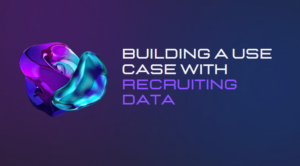
A use case is a description of how a particular system or process will be used to achieve a specific objective. In the context of recruiting data, a use case would involve identifying the steps in the recruiting process and analyzing the data to optimize the process for better efficiency, cost-effectiveness, and candidate quality.
By collecting data on recruitment metrics such as time to fill, cost per hire, and candidate quality, companies can use this information to make data-driven decisions and implement strategies that improve the recruitment process.
Examples of how to use recruiting data include using machine learning algorithms to automate resume screening, implementing pre-recorded video interviews to minimize scheduling conflicts, and developing a standardized interview process to ensure consistency in evaluating candidates. Ultimately, the use of recruiting data can help organizations to attract and hire the best talent while minimizing the resources required to do so.
Utilizing Talent Mapping data in a recruiting data use case
Talent mapping is the process of identifying and profiling potential candidates for a specific role or job function, even if they are not currently looking for a job. This process is important when creating a recruiting data use case because it allows organizations to take a proactive approach to recruiting, rather than simply reacting to open job postings.
By using talent mapping in conjunction with recruiting data, companies can identify trends and patterns in the types of candidates that are successful in specific roles, as well as the skills and qualifications that are in high demand. This information can help recruiters and hiring managers to develop more targeted job postings and recruitment strategies that are designed to attract the best talent for their organization.
Talent mapping can also be used to build a talent pipeline, which is a pool of potential candidates who have been identified and assessed as potential future hires. This can help organizations to reduce the time and cost associated with recruiting for future positions, as they will already have a pool of qualified candidates who have been pre-screened and vetted.
In summary, the use of talent mapping when creating a recruiting data use case is important because it allows organizations to take a more proactive approach to recruiting and identify top talent before they even begin their job search. This can lead to more efficient and effective recruitment processes, as well as a higher likelihood of success in attracting and hiring the best candidates.
Which data and sources should you use?
When creating a recruiting data use case, there are several types of internal data that can be important to consider. Some of the most important internal data points to consider are:
Recruitment Metrics: These metrics provide information on the effectiveness of the recruitment process, such as the time to fill positions, cost per hire, and applicant-to-hire ratio.
Employee Data: This data can provide insight into the skills, education, and experience of successful employees within the organization, which can help to inform recruitment strategies.
Performance Data: This data provides insight into the effectiveness of current employees, including their performance ratings and their ability to meet key performance indicators (KPIs).
Demographic Data: This data provides information on the gender, race, age, and other demographics of current employees, which can help to identify any gaps or opportunities for diversity and inclusion initiatives.
Turnover Data: This data provides insight into the reasons why employees are leaving the organization, which can help to identify areas for improvement in the recruitment process or employee retention strategies.
Skills Inventory: This data provides information on the skills and qualifications of current employees, which can help to identify areas where the organization may need to recruit new talent or provide additional training and development opportunities.
By analyzing this internal data, organizations can identify patterns and trends that can inform recruitment strategies and optimize the recruitment process for better efficiency and effectiveness.
Example of creating a recruiting data use case:
Title: Improving Recruiting Process Efficiency
Objective: To reduce the time and resources required to hire qualified candidates by optimizing the recruiting process.
Scenario: A company has a high volume of job openings and receives hundreds of applications for each position. The recruiting team spends a significant amount of time reviewing resumes and conducting phone screenings, which delays the hiring process and puts a strain on resources.
Data Analysis:
- Identify the key steps in the recruiting process, such as resume screening, phone screenings, and in-person interviews.
- Analyze the time and resources required for each step and determine where inefficiencies exist.
- Collect data on the quality of the candidates that progress through each step of the process and identify any patterns or trends.
Use Case:
- Use machine learning algorithms to automate the resume screening process and prioritize the most qualified candidates based on specific criteria, such as work experience and education.
- Implement pre-recorded video interviews to replace phone screenings, which will allow recruiters to review candidates on their own time and minimize scheduling conflicts.
- Utilize an applicant tracking system to monitor the progress of each candidate and identify bottlenecks in the recruiting process.
- Implement data analytics tools to track and analyze recruiting data, such as time to fill, cost per hire, and candidate quality, to identify areas for improvement and adjust recruiting strategies accordingly.
- Develop a standardized interview process and provide training to hiring managers to ensure a consistent and fair evaluation of candidates.
Expected Outcomes:
- Reduce the time to fill positions by 30%.
- Reduce the cost per hire by 20%.
- Increase the quality of hired candidates by 15%.
- Improve the candidate experience by providing a more efficient and transparent recruiting process.
- Increase recruiter productivity by reducing manual tasks and allowing them to focus on high-value activities, such as relationship building with candidates and hiring managers.
I recommend reading these additional articles on using data to drive decisions:
✔ Talent Mapping: Creating a data driven strategy
✔ Finding and resolving recruiting roadblocks
✔ Conducting Monthly and Quarterly Business Reviews in Recruiting
✔ How to create a recruitment dashboard
✔ Creating a data-driven talent sourcing strategy
✔ Tips to decrease your time to fill metrics
Recommended Reading:
Trending Talent Sourcing Tools in 2023
How to lead recruiting teams: Elevating your teams for growth
How to create an agile recruiting strategy
- AI Search Will Transform Talent Sourcing Forever - January 10, 2025
- Build an AI Sourcing Assistant using ChatGPT 4 - January 10, 2025
- Top Recruiting Leaders to Follow in 2025 - January 8, 2025
